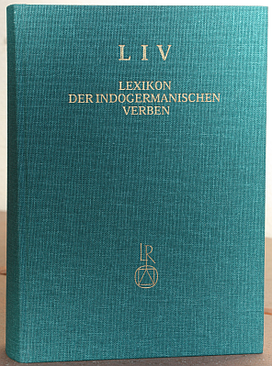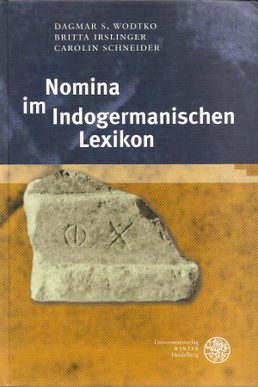
The Tocharianlanguages, also known as the Arśi-Kuči, Agnean-Kuchean or Kuchean-Agnean languages, are an extinct branch of the Indo-European language family spoken by inhabitants of the Tarim Basin, the Tocharians. The languages are known from manuscripts dating from the 5th to the 8th century AD, which were found in oasis cities on the northern edge of the Tarim Basin and the Lop Desert. The discovery of these languages in the early 20th century contradicted the formerly prevalent idea of an east–west division of the Indo-European language family as centum and satem languages, and prompted reinvigorated study of the Indo-European family. Scholars studying these manuscripts in the early 20th century identified their authors with the Tokharoi, a name used in ancient sources for people of Bactria (Tokharistan). Although this identification is now believed to be mistaken, "Tocharian" remains the usual term for these languages.

The laryngeal theory is a theory in historical linguistics positing that the Proto-Indo-European language included a number of laryngeal consonants that are not reconstructable by direct application of the comparative method to the Indo-European family. The "missing" sounds remain consonants of an indeterminate place of articulation towards the back of the mouth, though further information is difficult to derive. Proponents aim to use the theory to:

Proto-Germanic is the reconstructed proto-language of the Germanic branch of the Indo-European languages.
Proto-Indo-European (PIE) is the reconstructed common ancestor of the Indo-European language family. No direct record of Proto-Indo-European exists; its proposed features have been derived by linguistic reconstruction from documented Indo-European languages.
The ruki sound law, also known as the ruki rule or iurk rule, is a historical sound change that took place in the satem branches of the Indo-European language family, namely in Balto-Slavic, Armenian, and Indo-Iranian. According to this sound law, an original *s changed to *š after the consonants *r, *k, *g, *gʰ and the semi-vowels *w (*u̯) and *y (*i̯), as well as the syllabic allophones *r̥, *i, and *u:
A feature common to all Indo-European languages is the presence of a verb corresponding to the English verb to be.
Proto-Celtic, or Common Celtic, is the hypothetical ancestral proto-language of all known Celtic languages, and a descendant of Proto-Indo-European. It is not attested in writing but has been partly reconstructed through the comparative method. Proto-Celtic is generally thought to have been spoken between 1300 and 800 BC, after which it began to split into different languages. Proto-Celtic is often associated with the Urnfield culture and particularly with the Hallstatt culture. Celtic languages share common features with Italic languages that are not found in other branches of Indo-European, suggesting the possibility of an earlier Italo-Celtic linguistic unity.

The Lexikon der indogermanischen Verben is an etymological dictionary of the Proto-Indo-European (PIE) verb. The first edition appeared in 1998, edited by Helmut Rix. A second edition followed in 2001. The book may be seen as an update to the verb entries of the Indogermanisches etymologisches Wörterbuch (IEW) by Julius Pokorny. It was the first dictionary fully utilizing the modern three-laryngeal theory with reconstructions of Indo-European verbal roots.
As the Proto-Indo-European language (PIE) broke up, its sound system diverged as well, as evidenced in various sound laws associated with the daughter Indo-European languages. Especially notable is the palatalization that produced the satem languages, along with the associated ruki sound law. Other notable changes include:
Brugmann's law, named for Karl Brugmann, is a sound law stating that in the Indo-Iranian languages, the earlier Proto-Indo-European *o normally became *a in Proto-Indo-Iranian but *ā in open syllables if it was followed by one consonant and another vowel. For example, the Proto-Indo-European noun for 'wood' was *dόru, which in Vedic became dāru. Everywhere else, the outcome was *a, the same as the reflexes of PIE *e and *a.
The phonology of the Proto-Indo-European language (PIE) has been reconstructed by linguists, based on the similarities and differences among current and extinct Indo-European languages. Because PIE was not written, linguists must rely on the evidence of its earliest attested descendants, such as Hittite, Sanskrit, Ancient Greek, and Latin, to reconstruct its phonology.
The roots of the reconstructed Proto-Indo-European language (PIE) are basic parts of words to carry a lexical meaning, so-called morphemes. PIE roots usually have verbal meaning like "to eat" or "to run". Roots never occurred alone in the language. Complete inflected verbs, nouns, and adjectives were formed by adding further morphemes to a root and potentially changing the root's vowel in a process called ablaut.
Lachmann's law is a somewhat disputed phonological sound law for Latin named after German Indo-Europeanist Karl Lachmann who first formulated it sometime in the middle of the 19th century. According to it, vowels in Latin lengthen before Proto-Indo-European voiced stops which are followed by another (unvoiced) stop.
Szemerényi's law is both a sound change and a synchronic phonological rule that operated during an early stage of the Proto-Indo-European language (PIE). Though its effects are evident in many reconstructed as well as attested forms, it did not operate in late PIE, having become morphologized. It is named for Hungarian-British linguist Oswald Szemerényi.
Stang's law is a Proto-Indo-European (PIE) phonological rule named after the Norwegian linguist Christian Stang.
Siebs's law is a Proto-Indo-European (PIE) phonological rule named after the German linguist Theodor Siebs. According to this law, if an s-mobile is added to a root that starts with a voiced or aspirated stop, that stop is allophonically devoiced.
Proto-Indo-European accent refers to the accentual (stress) system of the Proto-Indo-European language.
Cowgill's law, named after Indo-Europeanist Warren Cowgill, refers to two unrelated sound changes, one occurring in Proto-Greek and the other in Proto-Germanic.
This glossary gives a general overview of the various sound laws that have been formulated by linguists for the various Indo-European languages. A concise description is given for each rule; more details are given in their articles.

Nomina im Indogermanischen Lexikon is an etymological dictionary of the Proto-Indo-European (PIE) nominals, that is, nouns and adjectives. It appeared in 2008, edited by German linguists Dagmar S. Wodtko, Britta Irslinger, and Carolin Schneider. Like other modern PIE dictionaries, NIL utilizes the modern three-laryngeal theory for its reconstructions.




